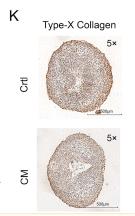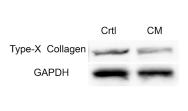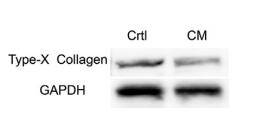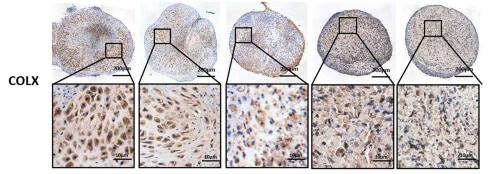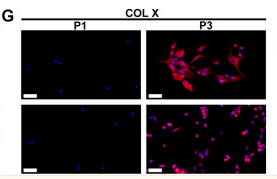Collagen X Antibody - #DF13214
| Product: | Collagen X Antibody |
| Catalog: | DF13214 |
| Description: | Rabbit polyclonal antibody to Collagen X |
| Application: | WB IHC |
| Cited expt.: | WB, IHC |
| Reactivity: | Human, Mouse, Rat |
| Prediction: | Pig, Bovine, Horse, Sheep, Rabbit, Chicken |
| Mol.Wt.: | 66kDa; 66kD(Calculated). |
| Uniprot: | Q03692 |
| RRID: | AB_2846233 |
Related Downloads
Protocols
Product Info
*The optimal dilutions should be determined by the end user. For optimal experimental results, antibody reuse is not recommended.
*Tips:
WB: For western blot detection of denatured protein samples. IHC: For immunohistochemical detection of paraffin sections (IHC-p) or frozen sections (IHC-f) of tissue samples. IF/ICC: For immunofluorescence detection of cell samples. ELISA(peptide): For ELISA detection of antigenic peptide.
Cite Format: Affinity Biosciences Cat# DF13214, RRID:AB_2846233.
Fold/Unfold
COAA1_HUMAN; Col10a 1; COL10A1; Collagen alpha 1(X) chain; Collagen alpha-1(X) chain; Collagen type X alpha 1 (Schmid metaphyseal chondrodysplasia); Collagen type X alpha 1; Collagen X alpha 1 polypeptide; CollagenX; fa66d11; fb10c08; OTTHUMP00000040411; Procollagen type X alpha 1; Schmid metaphyseal chondrodysplasia; wu:fa66d11; wu:fb10c08;
Immunogens
A synthesized peptide derived from human Collagen X, corresponding to a region within C-terminal amino acids.
- Q03692 COAA1_HUMAN:
- Protein BLAST With
- NCBI/
- ExPASy/
- Uniprot
MLPQIPFLLLVSLNLVHGVFYAERYQMPTGIKGPLPNTKTQFFIPYTIKSKGIAVRGEQGTPGPPGPAGPRGHPGPSGPPGKPGYGSPGLQGEPGLPGPPGPSAVGKPGVPGLPGKPGERGPYGPKGDVGPAGLPGPRGPPGPPGIPGPAGISVPGKPGQQGPTGAPGPRGFPGEKGAPGVPGMNGQKGEMGYGAPGRPGERGLPGPQGPTGPSGPPGVGKRGENGVPGQPGIKGDRGFPGEMGPIGPPGPQGPPGERGPEGIGKPGAAGAPGQPGIPGTKGLPGAPGIAGPPGPPGFGKPGLPGLKGERGPAGLPGGPGAKGEQGPAGLPGKPGLTGPPGNMGPQGPKGIPGSHGLPGPKGETGPAGPAGYPGAKGERGSPGSDGKPGYPGKPGLDGPKGNPGLPGPKGDPGVGGPPGLPGPVGPAGAKGMPGHNGEAGPRGAPGIPGTRGPIGPPGIPGFPGSKGDPGSPGPPGPAGIATKGLNGPTGPPGPPGPRGHSGEPGLPGPPGPPGPPGQAVMPEGFIKAGQRPSLSGTPLVSANQGVTGMPVSAFTVILSKAYPAIGTPIPFDKILYNRQQHYDPRTGIFTCQIPGIYYFSYHVHVKGTHVWVGLYKNGTPVMYTYDEYTKGYLDQASGSAIIDLTENDQVWLQLPNAESNGLYSSEYVHSSFSGFLVAPM
Predictions
Score>80(red) has high confidence and is suggested to be used for WB detection. *The prediction model is mainly based on the alignment of immunogen sequences, the results are for reference only, not as the basis of quality assurance.
High(score>80) Medium(80>score>50) Low(score<50) No confidence
Research Backgrounds
Type X collagen is a product of hypertrophic chondrocytes and has been localized to presumptive mineralization zones of hyaline cartilage.
Prolines at the third position of the tripeptide repeating unit (G-X-Y) are hydroxylated in some or all of the chains.
Secreted>Extracellular space>Extracellular matrix.
Research Fields
· Organismal Systems > Digestive system > Protein digestion and absorption.
References
Application: WB Species: human Sample: hBMSC
Application: IHC Species: Rat Sample:
Application: WB Species: Rat Sample:
Application: IHC Species: Rat Sample: SDSCs
Application: WB Species: Rat Sample: SDSCs
Application: WB Species: rat Sample: Costal chondrocytes
Application: IF/ICC Species: human and goat Sample:
Application: WB Species: Rat Sample:
Restrictive clause
Affinity Biosciences tests all products strictly. Citations are provided as a resource for additional applications that have not been validated by Affinity Biosciences. Please choose the appropriate format for each application and consult Materials and Methods sections for additional details about the use of any product in these publications.
For Research Use Only.
Not for use in diagnostic or therapeutic procedures. Not for resale. Not for distribution without written consent. Affinity Biosciences will not be held responsible for patent infringement or other violations that may occur with the use of our products. Affinity Biosciences, Affinity Biosciences Logo and all other trademarks are the property of Affinity Biosciences LTD.



